- Annapurna Base Camp Trek Overview
- Height | Elevation of Annapurna Base Camp
- Location of Annapurna Base Camp
- History of Annapurna Base Camp
- Best Highlights of Annapurna Base Camp
- How to reach Annapurna Base Camp?
- Annapurna Base Camp Trek Difficulty
- ABC Permits | Annapurna Base Camp Permits for 2025
- Travel insurance
- Best time to Trek Annapurna Base Camp
- Challenges of Annapurna Base Camp Trek
- Acclimatization during Annapurna Base Camp Trek
- ABC Trek Itinerary & Duration:
- ABC Trek Route
- Annapurna Base Camp Map | ABC Itinerary Map
- Annapurna Base Camp Detail Cost:
- Trail Conditions:
- What to Pack for Annapurna Base Camp?
- Guide and Porter
- Accommodation and Food during ABC Trek
- Cultural Experiences:
- Electricity on Annapurna Base Camp Trek
- Wi-Fi and Internet
- Network Coverage
- Drinking Water
- Toilet Facilities
- Showers and Hygiene:
The Annapurna Base Camp lies at the base of the tenth-highest mountain in the world, the Annapurna I (8091m). It is the final destination of the Annapurna Base Camp Trek, one of the most popular treks in the Nepal Himalayas. Located at an altitude of 4130m, the Annapurna Base Camp can be reached via a foot trail running across lush forests, traditional Gurung villages, terraced fields, Himalayan rivers, and hot springs. The ABC Trek is one of the shortest and most doable high-altitude treks in Nepal.
Easier than the Everest Base Camp Trek and with an easily accessible route, the Annapurna Base Camp Trek is a favorite among tourists trekking for the first time in Nepal. Depending on the route one chooses, the trek can last anywhere between ten and five days.
The shortest route to ABC is the one from Kimchi and Ghandruk. If you are fit enough, you can complete the Annapurna Base Camp Trek in five days via this route. The route from Nayapul or Tikhedhunga takes longer (around 9-10 days), but the experience is richer as one gets to trek via the beautiful rhododendron forests of Ghorepani and visit the Himalayan viewpoint of Poon Hill. Starting your trek from Kande takes you past the beautiful Australian Camp and the rarely visited Gurung villages of Tolka, Pothana, and Landruk.
The major stops en route to Annapurna Base Camp are Ghandruk, Jhinu Danda, Chhomrong, Sinuwa, Bamboo, Dovan, Himalaya, Deurali, Machapucchre Base Camp, and finally, Annapurna Base Camp.
Annapurna Base Camp Trek Overview
Difficulty: The Annapurna Base Camp (ABC) trek is considered a moderate-level trek, making it accessible to both beginners and experienced trekkers. While it doesn't require advanced mountaineering skills, it does present challenges like altitude gain, uneven terrain, and unpredictable weather. The trek reaches a maximum altitude of 4,130 meters (13,550 feet), and acclimatization is crucial.
Altitude: Proper acclimatization is essential to avoid altitude sickness.
Duration: The trek typically lasts 7-12 days, depending on the route and acclimatization.
Terrain: The trail varies from well-marked paths to rocky and steep sections.
Accommodation: Teahouses are available along the route, with basic facilities at higher altitudes.
Weather: Weather can be unpredictable, especially at higher elevations, so proper clothing and gear are essential.
Height | Elevation of Annapurna Base Camp
Annapurna Base Camp is situated at an altitude of 4,130 meters (13,550 feet) above sea level. This makes it a significant high-altitude trekking destination in the Annapurna region of Nepal. Reaching the base camp is the culmination of the Annapurna Base Camp trek, a popular trekking route in Nepal. The views from the base camp include Annapurna I, Annapurna South, and the surrounding Annapurna Sanctuary.
How high is Annapurna Base Camp?

Location of Annapurna Base Camp
Annapurna Base Camp is located in the Annapurna Conservation Area of Nepal, specifically within the Kaski District of Gandaki Pradesh. It is located the base of the world's tenth-highest mountain, Annapurna I. The trek to the base camp starts from Dhampus Phedi or Nayapul, which is about 1.5 hours from Pokhara. The base camp itself is situated at an altitude of 4,130 meters.
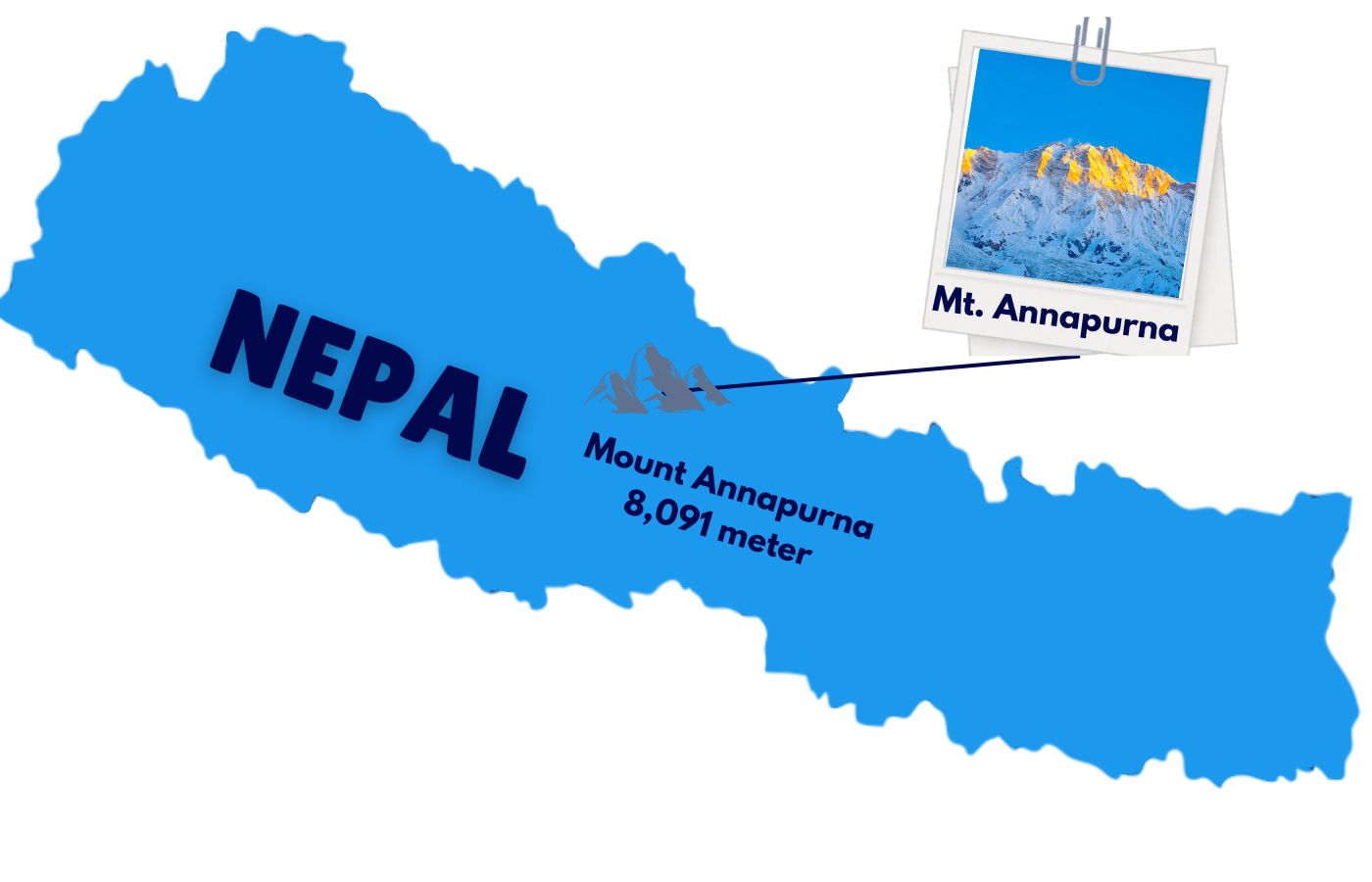
Where is Annapurna Base Camp Located?
The spirit of Annapurna, the heart of the Great Mother, rests within the Annapurna Sanctuary, a great circle of mountains nestled deep within the heart of the Himalayas. It is a place of power and beauty, a realm of stone and sky where the earth whispers ancient tales.
To reach the Sanctuary, one must journey from the warm, fertile valleys towards the cold embrace of the mountains. The path winds upward, past villages where the whispers of the Gurung people echo through the air. The air grows thin, the stones more rugged, and the silence more profound. The journey is a pilgrimage, a slow and steady ascent into the realm of the spirits.
History of Annapurna Base Camp
The Annapurna Base Camp trek has a long history, dating back to ancient times when it was a pilgrimage route to the sacred Annapurna Sanctuary. The trek was also a trade route between Nepal and Tibet, used by locals for transporting goods. Modern tourism brought it into the spotlight in the 1960s, with the first organized trekking expeditions.
Ancient Pilgrimage and Trade Route: The trek was initially a pilgrimage route to the Annapurna Sanctuary, a sacred area for Hindus and Buddhists, seeking blessings from the Annapurna Mata (goddess of food and nourishment). It was also a trade route between Nepal and Tibet, used by locals to transport goods and supplies.
Early Mountaineering: The Annapurna region, and specifically Annapurna I (part of the Annapurna massif), attracted climbers in the early 1900s. In 1950, a French expedition led by Maurice Herzog successfully reached the summit of Annapurna I, making it the first 8,000-meter peak to be climbed. This pioneering ascent, although at a high cost (Herzog suffered severe frostbite), established Annapurna as a destination for serious mountaineers.
Best Highlights of Annapurna Base Camp
- Annapurna Base Camp is located under the shadows of the magnificent Annapurna Massif. One can enjoy close-up views of Annapurna I (the tenth highest mountain in the world), Annapurna II, III and IV, Annapurna South, Hiunchuli, Gangapurna, Dhaulagiri(the seventh highest mountain in the world), Manaslu(the eighth highest mountain in the world), Tilicho Peak, and Pisang Peak.
- At night you can savor a spectacular view of the Milky Way. The stars and galaxies appear closer to the base camp.
- On your way to ABC, you cross the longest suspension in the Kaski district. The bridge, which is 287 meters long and 135 meters high is built over the Modi River and connects Jhinu Danda with other Gurung villages.
- The hot spring at Jhinu Danda offers a welcome respite from the tiring trek. You can enjoy a relaxing dip in the hot spring with healing properties.
- En route are traditional Gurung villages with charming clay and stone houses. Each night you can stay at a teahouse or lodge owned by a local family. The trek to ABC offers you a great opportunity to learn more about the rural lifestyle and culture of the Gurung community.
- The route is clean and well-maintained. The stone steps are well constructed, and the villagers regularly clear the path along the forest.
- Before reaching the Annapurna Base Camp, you cross the Machhapucchre Base Camp, which lies at the foot of the sacred Fishtail Peak or Machhapucchre. One of the unclimbed mountains in Nepal, stepping on Fishtail Peak is strictly prohibited as the Gurungs consider the mountain as their guardian deity.
- Annapurna Sanctuary, a glacial basin that lies close to ABC is a sacred place for the locals. Known as the abode of the gods, the Annapurna Sanctuary offers breathtaking views of the Annapurna Massif and other Himalayan giants.
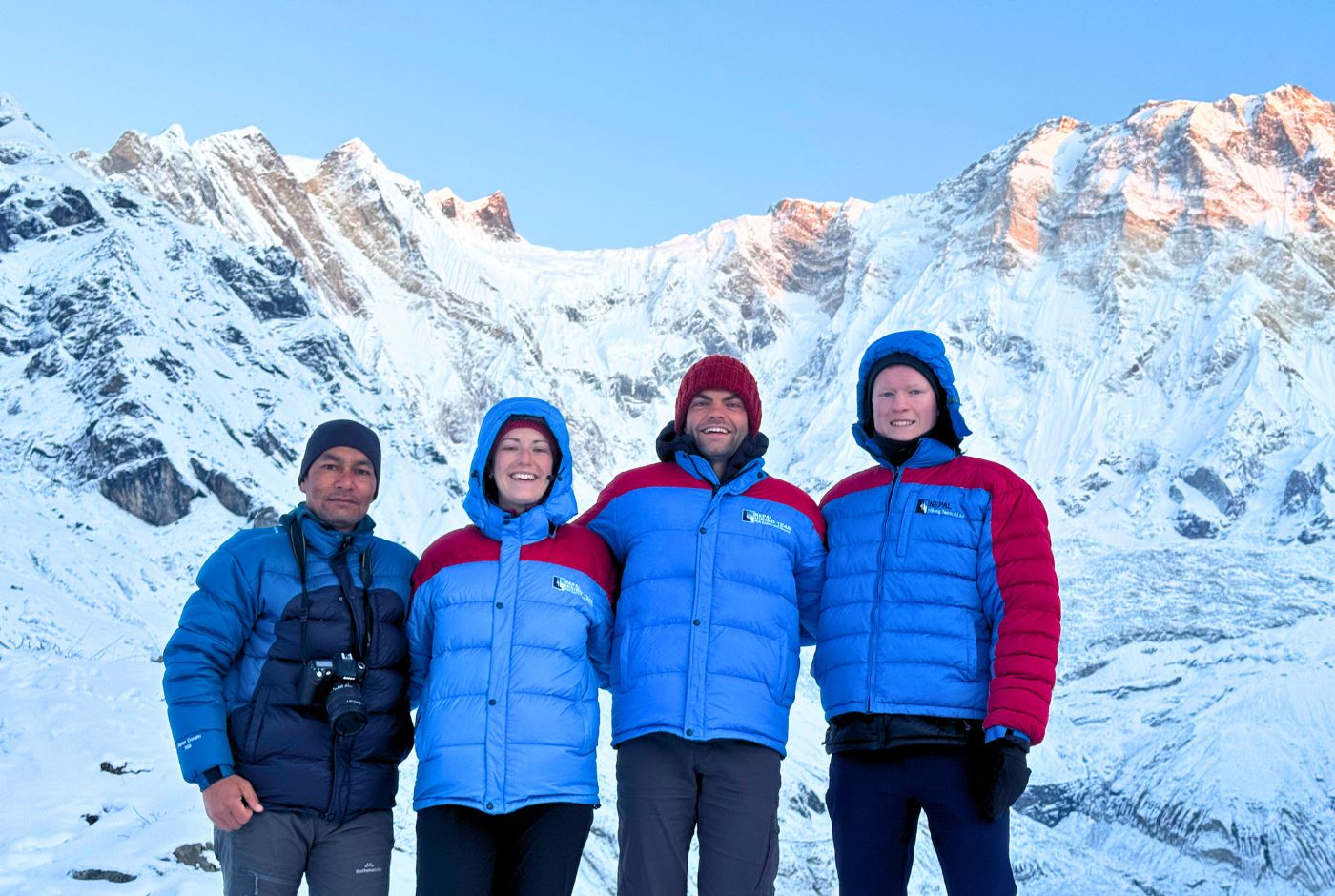
How to reach Annapurna Base Camp?
Reaching Pokhara – Gateway to Annapurna
From Kathmandu to Pokhara:
- By Air: A short 30-minute domestic flight connects Tribhuvan International Airport (Kathmandu) to Pokhara Airport. Ideal for those with limited time.
- By Road: A tourist bus, hire a taaxi or private vehicle takes about 7–8 hours, offering scenic views along the Prithvi Highway.
Why Pokhara? Pokhara is the launchpad for treks in the Annapurna region. It's also a great place to acclimate, pick up last-minute gear, and enjoy lakeside views before the journey begins.
The drive from Pokhara to Tikhedunga takes around 2 hours, while the drive to Kande takes about an hour. Each day's trek lasts for 5 to 7 hours. There are some steep ascents and descents en route and lots of stair climbing. None of these need technical skills.
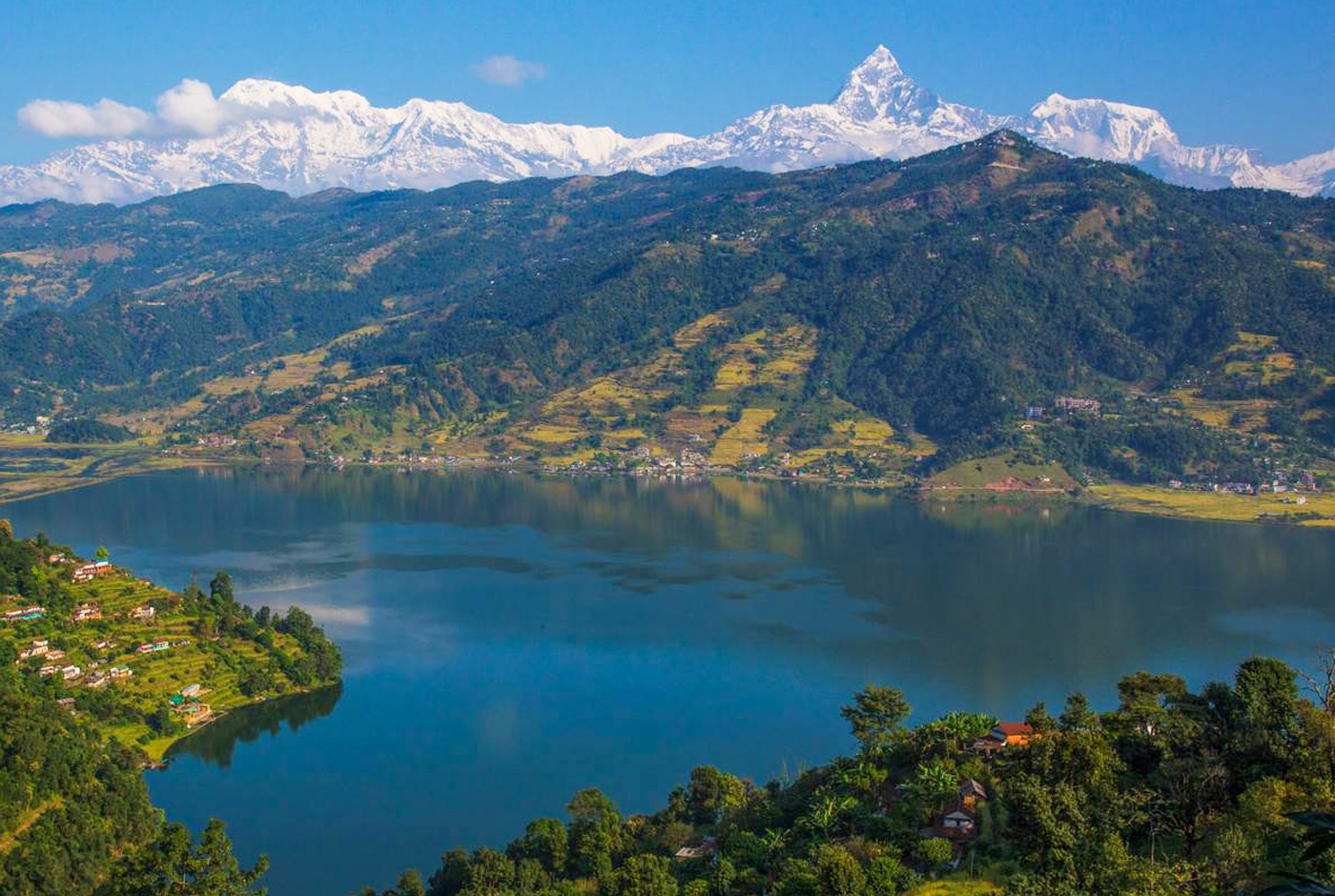
Trek Starting Points: Nayapul or Ghandruk
Option 1: Nayapul
- Drive Time from Pokhara: ~1.5 hours
- Trek Begins: From Nayapul (1,070m), passing Birethanti — a permit checkpoint and trail junction.
Option 2: Ghandruk: Drive Time from Pokhara: ~3 hours
Why Ghandruk? Starting from Ghandruk (1,940m) shortens the trek by a day and reduces initial ascents. Ideal for travelers preferring a less strenuous start.
Most tourists these days prefer to head directly to Ghandruk Village or Kimchi as the route from the village is the shortest to ABC. Depending on the condition of the road, it can take anywhere between 4 to 6 hours to reach Ghandruk from Pokhara.
Annapurna Base Camp Trek Difficulty
The Annapurna Base Camp trek difficulty is considered a moderately challenging level, making it accessible to both first-time trekkers and those with prior experience. It requires a reasonable level of fitness, mental preparedness, and proper pacing. One of the key challenges is altitude, as the trail ascends to a maximum elevation of 4,130 meters (13,547 feet) at Annapurna Base Camp. At this height, trekkers may face symptoms of altitude sickness, so proper acclimatization and gradual ascent are essential.
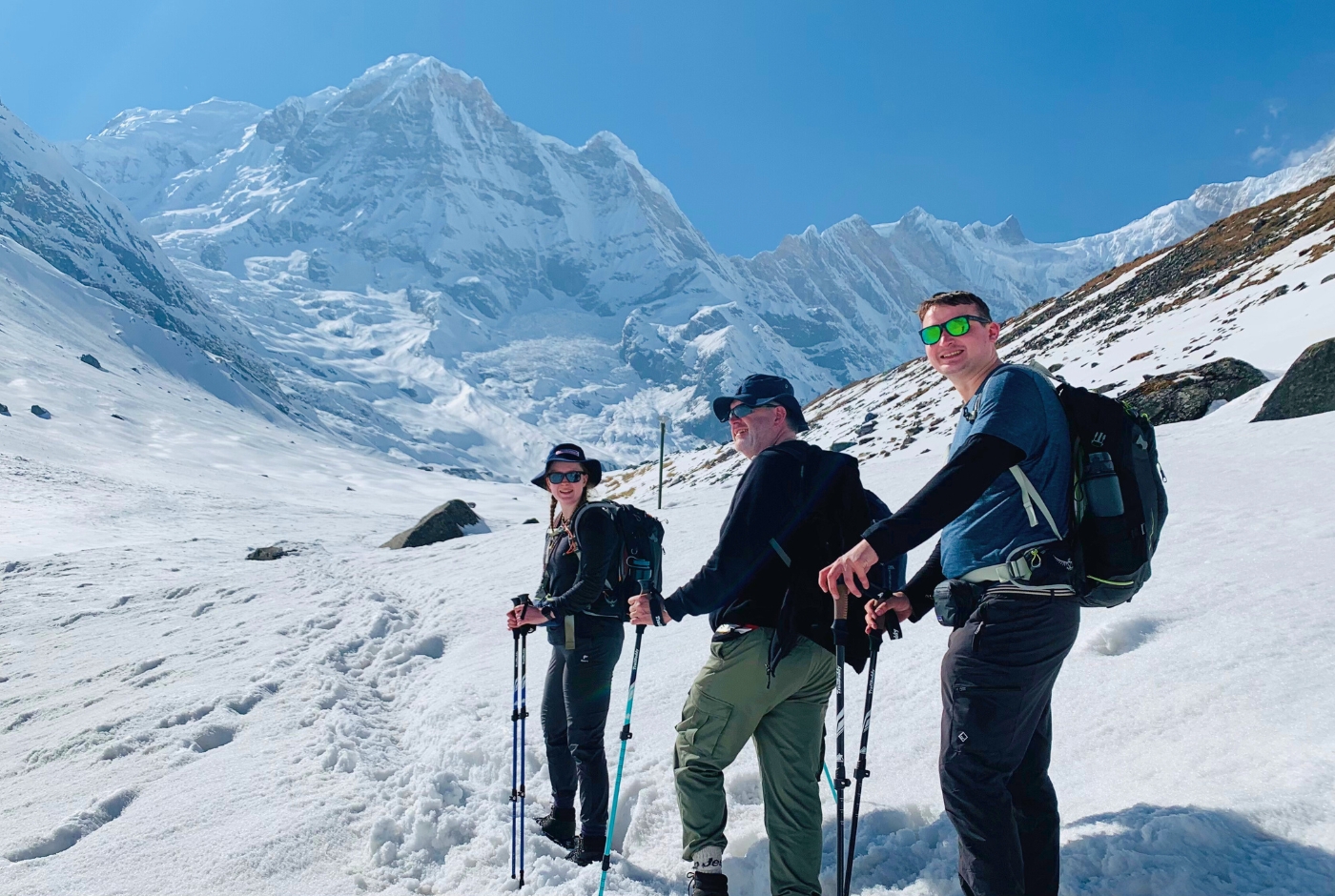
How difficult is the Annapurna Base Camp Trek?
- Duration: Covering approximately 110 kilometers (68 miles), the trek typically takes 7 to 11 days, with daily hikes ranging from 5 to 7 hours.
- Terrain: The terrain is varied and includes steep ascents and descents, rocky paths, dense forests, and long stretches of stone staircases that demand stamina and endurance.
- Weather: Weather conditions can shift quickly, with the possibility of rain, snow, or extreme cold at higher elevations, adding an extra layer of difficulty. While the trek doesn’t require technical climbing skills, a solid fitness base helps significantly.
- Preparation: Preparing with regular hikes, especially on uneven terrain and while carrying a loaded backpack, can make the journey more comfortable.
- Guide and Porter: Hiring a guide and porter is highly recommended—not merely for safety and navigation but also to reduce physical strain and enhance cultural engagement along the way.
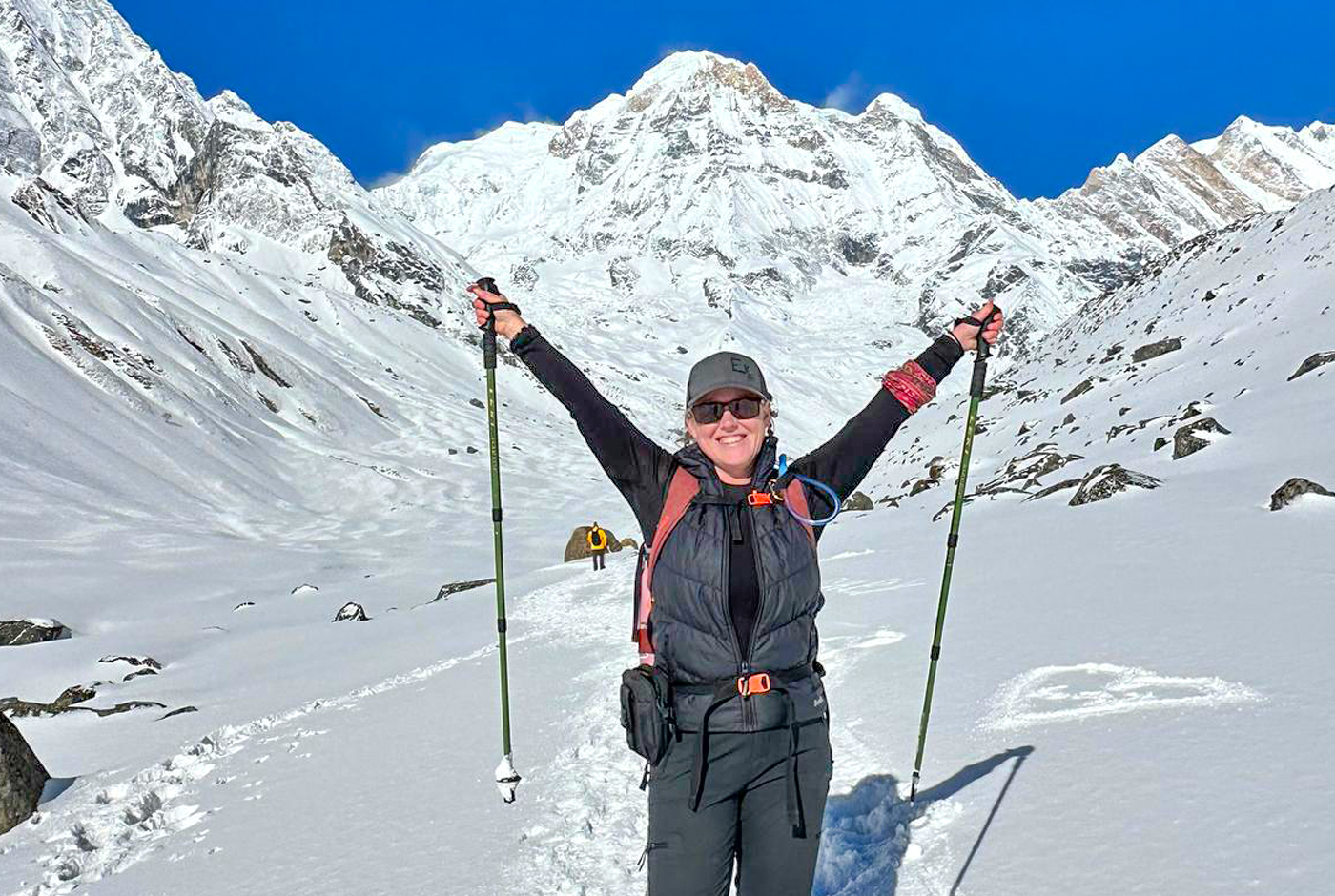
ABC Permits | Annapurna Base Camp Permits for 2025
To undertake the Annapurna Base Camp (ABC) trek, securing the necessary permits is essential for both legal compliance and the preservation of the region's natural beauty. As of March 2025, the primary permit required is the Annapurna Conservation Area Permit (ACAP).
What permits are necessary for the ABC Trek?
Annapurna Conservation Area Permit (ACAP):
Purpose: This permit grants access to the Annapurna Conservation Area, supporting conservation efforts and sustainable tourism initiatives within the region.
Cost:
- Foreign Nationals: NPR 3,000 per person (approximately USD 30).
- SAARC Nationals: NPR 1,000 per person (approximately USD 10).
Obtaining the ACAP: Trekkers can acquire the ACAP at the Nepal Tourism Board offices located in Kathmandu or Pokhara. To obtain this permit, you will need to provide a copy of your passport, two passport-sized photographs, and details of your trekking itinerary. It's advisable to carry the exact amount in Nepalese Rupees, as some offices may not accept other currencies or credit cards.
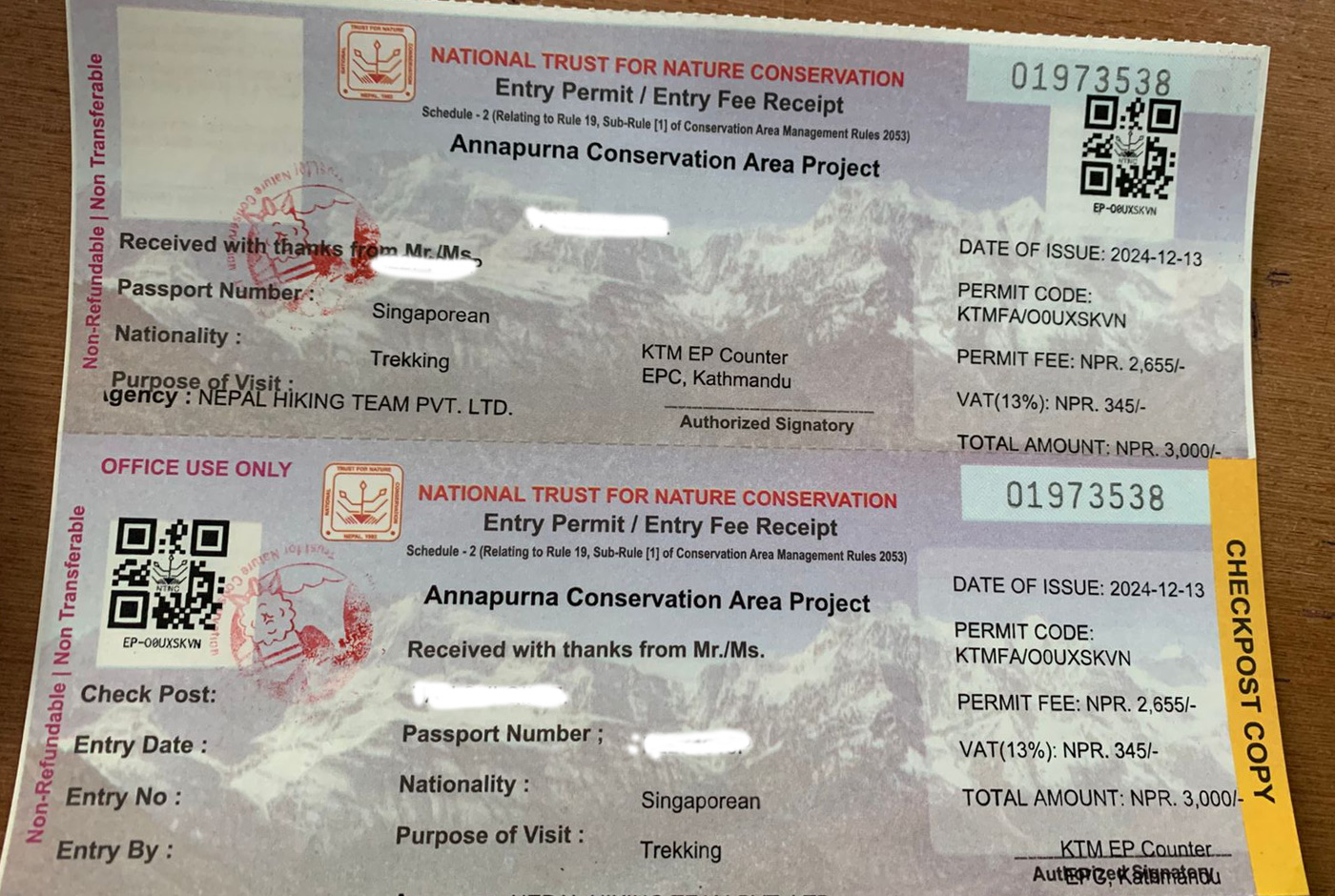
Trekkers' Information Management System (TIMS) Card:
Previously, the TIMS card was a mandatory requirement for trekkers in Nepal. However, as of April 1, 2023, the necessity for a TIMS card has been removed for the Annapurna region. Trekkers are no longer required to obtain this card for the ABC trek.
Important Considerations:
- Permit Verification: Ensure you keep your ACAP permit accessible, as you will need to present it at various checkpoints throughout the trek. Failure to produce a valid permit can result in fines or denial of entry beyond certain points.
- Guides and Porters: While not mandatory, hiring a licensed guide and/or porter can enhance your trekking experience, provide local insights, and assist in emergencies. Engaging local professionals also supports the local economy.
- Regulation Updates: Trekking regulations and permit requirements can change. It's recommended to verify the current requirements with official sources or through a reputable trekking agency before commencing your trek.
By obtaining the necessary permits and adhering to local regulations, you contribute to the conservation efforts and sustainable tourism practices that keep the Annapurna region pristine and welcoming for future trekkers.
Travel insurance
For travel insurance covering an Annapurna Base Camp trek guide, ensure it includes comprehensive medical coverage, emergency evacuation (including helicopter rescue), coverage for high-altitude trekking (above 5000 meters), and trip cancellation/interruption, plus other standard travel insurance benefits.
What should it cover?
Medical Coverage:
- Altitude Sickness: The trek reaches elevations where altitude sickness can occur. Ensure your insurance covers treatment for this condition.
- Medical Expenses: Your policy should cover costs for doctor visits, hospital stays, and necessary medications during the trek.
Emergency Evacuation:
- Helicopter Rescue: In remote Himalayan regions, helicopter evacuation is often the quickest way to receive medical attention. Confirm that your insurance covers helicopter rescues up to 5,000 meters.
- Repatriation: Ensure your policy includes coverage for returning you to your home country or a suitable medical facility if necessary.
Trip Cancellation/Interruption:
- Unforeseen Events: Life is unpredictable. Your insurance should reimburse non-refundable expenses if your trip is canceled or cut short due to illness, injury, or other unexpected events.
Baggage and Personal Belongings:
- Trekking Gear: Trekking equipment is vital for your journey. Ensure your policy covers loss, theft, or damage to your gear.
Adventure Activities Coverage:
Trekking: Not all insurance policies cover adventure activities. Verify that trekking at high altitudes is included in your coverage.
Personal Liability:
Accidental Damage: Accidents can happen. Ensure your policy protects you if you're held responsible for injury or property damage during your trek.
Additional Considerations:
- Policy Limits: Some insurers have altitude restrictions. Ensure your policy covers trekking up to 6,000 meters to encompass the Annapurna Base Camp trek.
- Provider Recommendations: It's advisable to choose reputable insurance providers familiar with the requirements of high-altitude trekking in Nepal.
Having the right travel insurance ensures you can fully enjoy the breathtaking landscapes of the Annapurna region, knowing you're protected against potential challenges.
Best time to Trek Annapurna Base Camp
The best time to trek to Annapurna Base Camp is during the spring (March to May) and autumn (late September to November) seasons. These periods offer the most stable weather, clear skies, and comfortable temperatures, creating ideal conditions for a rewarding trekking experience.
Spring (March to May)
- Spring is a particularly vibrant and popular season for the Annapurna Base Camp trek.
- The weather during this time is generally pleasant, with warm days and cool nights. Rain and snowfall are rare, ensuring dry, stable trails that are easier to complete.
- One of spring’s most captivating features is the explosion of color in the rhododendron forests, which come alive in full bloom.
- As you trek through the region, you'll be surrounded by lush greenery, colorful blossoms, and panoramic views of the Annapurna range under crisp, clear skies. The visibility is excellent, making it a perfect season for mountain photography.
- Spring of Nepal also coincides with several cultural events, such as Nepal's New Year and Chaitra Dashain, giving trekkers a chance to witness local traditions along the route.
- However, due to its popularity, spring can be quite busy, especially on the more accessible sections of the trail.

Annapurna Base Camp Trek Review during Spring
No words or photos can describe the trekking to Annapurna Base Camp and back. It was awesome, it was incredibly hard, and it was mind-blowingly beautiful. The trek was amazing and I loved the slippery slopes coming down from Machhapuchhre Base Camp. Read more
Aututmn (September - November)
- Autumn, particularly from late September through November, is another outstanding time to undertake the trek. Following the summer monsoon, the air is fresh, clean, and free of dust, offering crystal-clear views of the Himalayas.
- Temperatures during the day are comfortably warm, while nights are cool but not harsh. Like spring, rainfall is minimal, keeping the trails dry and making for safer and more enjoyable trekking conditions.
- Although the natural scenery is less floral than in spring, autumn has its own charm, with golden-hued forests, ripening crops, and sweeping mountain vistas.
- The season is also rich in cultural experiences, with Nepal’s two major festivals—Dashain and Tihar—celebrated during this time. These festivals provide unique insight into local life and traditions, adding a cultural dimension to your journey.
- Autumn is also a peak trekking season, so while the trails are well-maintained and the teahouses open and prepared, expect to share the path with many fellow adventurers.
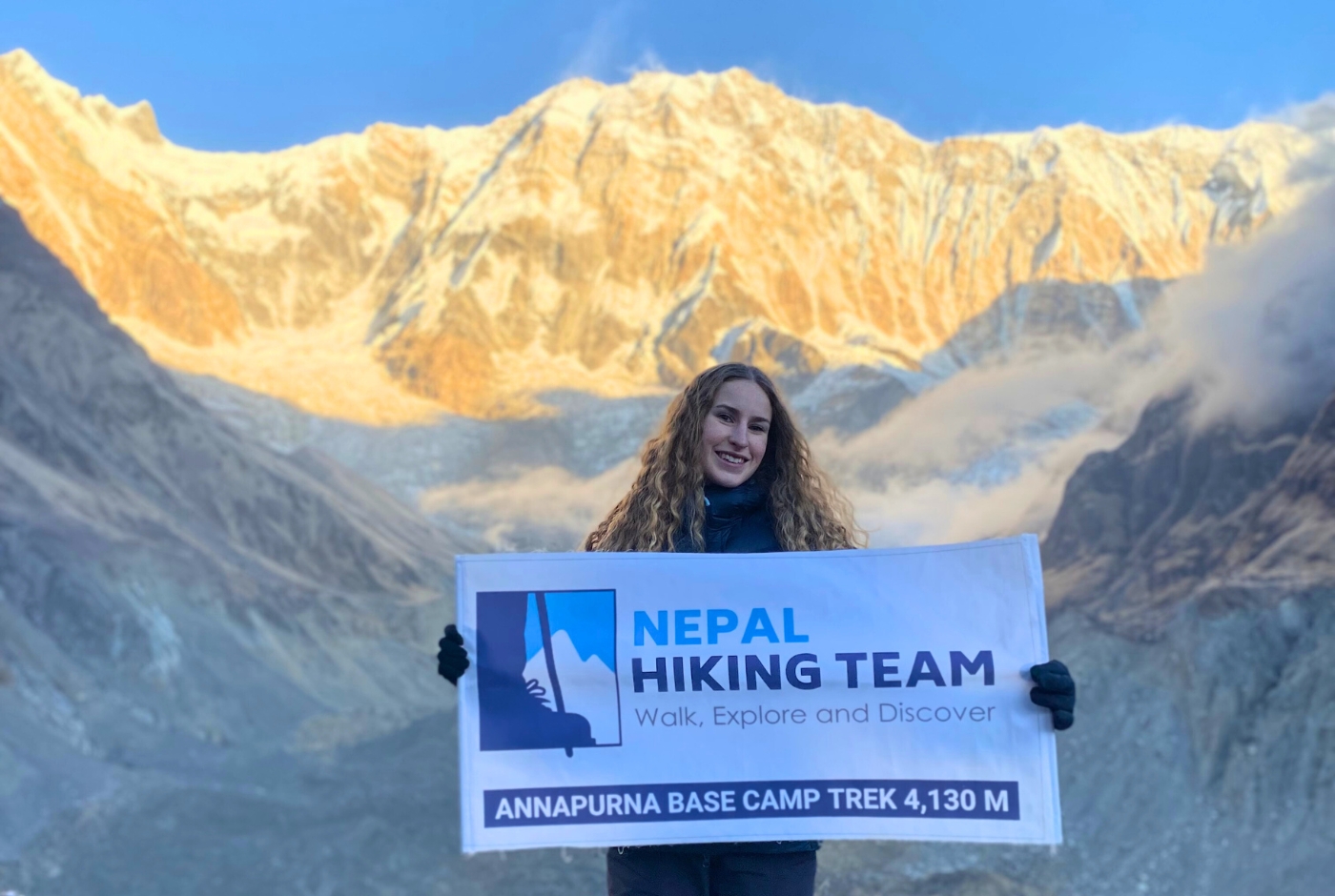
Annapurna Base Camp Trek Review during Autumn
I completed the Annapurna Base Camp Short Trek with Nepal Hiking Team in October this year. I joined with my friend, who had used Nepal Hiking Team before and highly recommended them. Their service lived up to the praise. Read More
When to Avoid? And Why?
The Annapurna Base Camp trek is best avoided during the winter (December to February) and monsoon (June to August) seasons due to challenging and potentially dangerous conditions. These periods bring harsh weather that significantly affects trail safety, visibility, and overall trekking experience.
Winter
- Winter conditions can be severe, particularly at higher altitudes.
- Temperatures often drop well below freezing, increasing the risk of frostbite and hypothermia.
- Snowfall is common and can quickly cover trails, making them difficult to follow and raising the likelihood of slips and injuries. In some areas, snow accumulation also increases the risk of avalanches, especially where slopes are unstable.
- Additionally, many lodges and teahouses close for the season, limiting access to essential services such as food, shelter, and emergency support.
- For these reasons, winter trekking in the Annapurna region requires specialist equipment and experience, and it remains unsuitable for most travelers.
Monsoon
- Monsoon brings its own set of difficulties.
- Torrential rainfall often leads to muddy and slippery trails, which can be hazardous even for experienced trekkers.
- Landslides are a common occurrence during this time, especially in areas with steep terrain and unstable soil.
- These can block paths, damage infrastructure, and pose serious safety risks. Persistent cloud cover and heavy rain frequently obscure mountain views, and trail conditions can shift quickly.
- The increased presence of leeches and insects during the wet season also adds discomfort. Travel disruptions are frequent, as flights to and from regional airports may be delayed or cancelled due to poor weather, complicating itineraries and logistics.
Challenges of Annapurna Base Camp Trek
The Annapurna Base Camp trek presents several challenges, including altitude sickness, varying terrain, unpredictable weather, and physical exertion. Altitude is a significant factor, with the trek reaching elevations above 4,000 meters (13,123 feet), potentially leading to symptoms like headaches and dizziness. The diverse terrain, ranging from steep ascents and descents to rocky paths and river crossings, requires agility and endurance. Weather conditions can be harsh and unpredictable, with potential for rain, snow, and landslides, especially during the monsoon and winter seasons. Finally, the long distances and demanding daily treks can lead to fatigue and require a good level of physical fitness.
Acclimatization during Annapurna Base Camp Trek
Proper acclimatization is crucial for a safe and successful Annapurna Base Camp (ABC) trek. It involves a gradual ascent, allowing your body to adjust to the decreasing oxygen levels at higher altitudes. This includes following the "climb high, sleep low" principle, staying hydrated, and avoiding strenuous activities on acclimatization days.
- Gradual Ascent: Avoid rapid altitude gains, especially in the initial stages of the trek. Limit daily elevation increases to 300-500 meters.
- "Climb High, Sleep Low": Spend daytime at higher altitudes and return to a lower altitude for sleeping to allow your body to adjust to the increased altitude.
- Rest Days: Incorporate rest days into your itinerary to allow your body to acclimatize effectively.
- Hydration: Drink plenty of fluids, especially water, to stay hydrated.
- Balanced Diet: Consume a balanced diet, including carbohydrates for energy.
- Avoid: Smoking, alcohol, and excessive caffeine.
- Medication: Consult with a doctor about taking Diamox or other medications to help with acclimatization.
- Listen to Your Body: If you experience symptoms of altitude sickness, descend to a lower altitude immediately.
- Pre-Acclimatization: If possible, spend time at altitude before your trek to help your body adapt.
ABC Trek Itinerary & Duration:
The Annapurna Base Camp trek is a widely favored Himalayan journey that typically spans 7 to 12 days, starting and ending in Pokhara. The trek takes you through terraced farmlands, dense rhododendron forests, and traditional Gurung and Magar villages before reaching the iconic Machhapuchhre Base Camp (MBC) and the breathtaking Annapurna Base Camp (ABC).
Most treks begin with a scenic drive from Pokhara to Nayapul or Jhinu, followed by daily hikes through varied terrain and elevations. The route offers a mix of cultural immersion and natural beauty, with panoramic views of Annapurna I, Hiunchuli, Machhapuchhre, and other towering peaks along the way.
Annapurna Base Camp 7-Day Itinerary Sample
- Day 1: Drive from Pokhara to Nayapul (or Jhinu), trek to Ghandruk or Chhomrong
- Day 2: Trek to Chhomrong (if starting from Ghandruk) or continue to Sinuwa
- Day 3: Trek to Bamboo or Deurali
- Day 4: Trek to Machhapuchhre Base Camp (MBC)
- Day 5: Hike to Annapurna Base Camp (ABC), then return to Bamboo
- Day 6: Trek back to Jhinu (or Chhomrong)
- Day 7: Trek to Nayapul, drive back to Pokhara
Shortest ABC Trek Itinerary
- Day 01: Drive from Pokhara – Nayapul – Jhinu - Trek to Sinuwa
- Day 02: Sinuwa – Bamboo – Deurali
- Day 03: Deurali – Machhapurchhe Base Camp – Annapurna Base Camp
- Day 04: ABC – MBC – Deurari – Bamboo
- Day 05: Bamboo – Choomrung – Jhinu, then Drive to Pokhara.
Alternative Itineraries
ABC Trek 10–12 Day Itinerary:
Incorporates a detour via Ghorepani and Poon Hill, offering stunning sunrise views and better acclimatization. This version is ideal for those who prefer a slower pace or wish to extend their trekking experience with added cultural and scenic value.
Annapurna Base Camp 5-Day Itinerary:
Designed for travelers with limited time, this condensed route focuses on key highlights and follows a more direct trail to ABC, with fewer stops and longer daily walks.
Annapurna Base Camp 13-15 Day Itinerary:
This 13–15 day itinerary is specially designed for seniors and children who prefer a slower pace, shorter walking hours, and ample time for rest and acclimatization.
Customized Itineraries:
As a leading local operator, Nepal Hiking Team offers flexible trekking plans tailored to different fitness levels, schedules, and interests. Whether you're seeking a relaxed pace, a photography-focused trek, or a more challenging route, we ensure every itinerary delivers a meaningful experience.
ABC Trek Route
The Annapurna Base Camp (ABC) trek is a classic Himalayan adventure that typically spans 7 to 10 days, depending on your pace and chosen route. Starting from Nayapul or Ulleri near Pokhara, the trail meanders through charming villages like Ghandruk, Chhomrong, and Sinuwa, following the Modi Khola River and ascending through lush forests and alpine meadows. The journey culminates at the base of Annapurna I, offering trekkers a blend of natural beauty and cultural immersion.
ABC Updated 2025 Itinerary:
- Day 1: Drive from Pokhara to Nayapul or Ulleri (1.5–2 hours), then trek to Ghandruk. This Gurung village provides stunning mountain views and a warm welcome.
- Day 2: Trek to Chhomrong, passing through terraced fields and rhododendron forests. Chhomrong offers panoramic vistas and is a key stop before ascending further.
- Day 3: Continue to Bamboo via Sinuwa, descending into the forested Modi Khola valley. The trail is serene, with chances to spot local wildlife.
- Day 4: Ascend to Deurali, navigating through dense forests and past waterfalls. The altitude begins to increase noticeably here.
- Day 5: Trek to Machhapuchhre Base Camp (MBC), situated at 3,700 meters. The landscape transforms into alpine terrain, with close-up views of the surrounding peaks.
- Day 6: Reach Annapurna Base Camp (4,130 meters), surrounded by towering mountains. Spend time soaking in the breathtaking scenery before descending back to Bamboo.
- Day 7: Descend to Jhinu Danda, where you can relax in natural hot springs—a perfect way to soothe tired muscles.
- Day 8: Trek to Syauli Bazaar and drive back to Pokhara, concluding your trek.
For those with extra time, optional routes include detours to Poon Hill for sunrise views or extended stays in local villages to experience Gurung and Magar cultures more deeply. This itinerary offers a balanced mix of challenging hikes, cultural encounters, and stunning natural beauty, making it a memorable trekking experience in the heart of the Himalayas.
Annapurna Base Camp Map | ABC Itinerary Map
Elevation Chart and Map of Annapurna Base Camp Trek
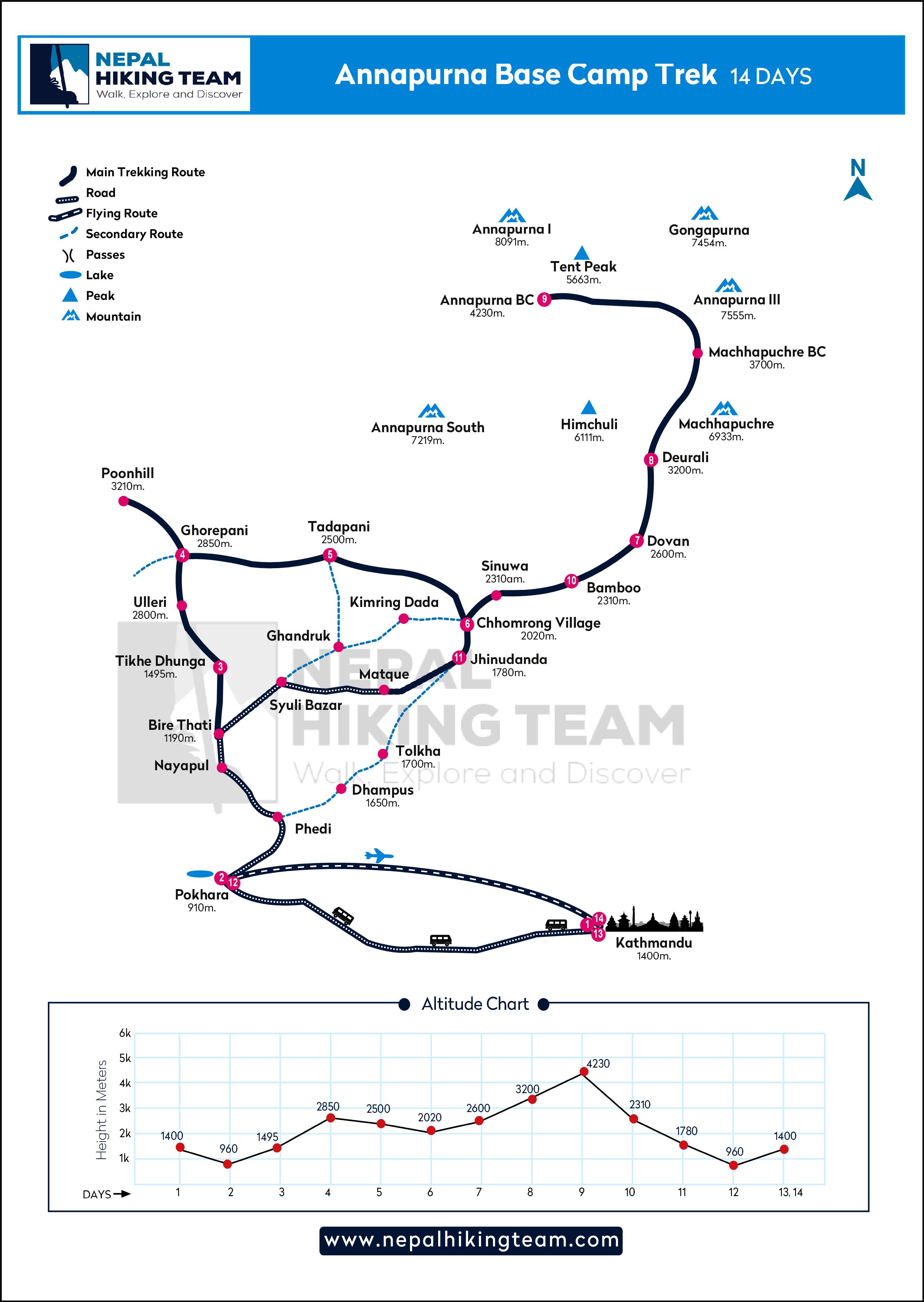
Annapurna Base Camp Detail Cost:
The cost of an Annapurna Base Camp trek typically ranges from $600 to $2,500+ per person, depending on key factors such as trip length, time of year, service level, and trekking style. Here's a concise breakdown to help you plan and budget effectively:
Factors Affecting the Cost of the ABC Trek 2025
- Duration: Longer treks cost more due to additional accommodation, food, and guiding days.
- Season: Prices rise in peak trekking months (March–May, September–November) due to higher demand.
- Accommodation: Choices range from budget teahouses to higher-end hotels in Pokhara.
- Transportation: Flights or private vehicles to/from Pokhara and trailheads add to the overall cost.
- Services Included: Guided tours with porters, permits, meals, and equipment rentals increase the package price.
- Trekking Agency: Rates vary based on reputation, inclusions, and service quality.
Cost Breakdown
- Budget-Friendly Packages: $600 – $1,000
- Standard Packages: $1,000 – $1,500
- Luxury Treks: $2,000 – $2,500+
Flights to Pokhara (round trip): Around $200
- Permits: ACAP and TIMS permits (approximately $50–60 total)
- Guide & Porter: Adds value, safety, and comfort (approx. $25–35 per day combined)
- Equipment Rental: Sleeping bag/down jacket rental costs about $1.70 – $4.25 per item, per day
Tips for Budgeting
- Travel in Shoulder Season: April–May and October–November offer good weather with slightly lower rates.
- Join a Group Trek: Group packages reduce per-person costs and are ideal for solo trekkers.
- Bring Your Own Gear: Saves on daily rental expenses.
- Eat Local: Local tea houses and cafés offer cheaper meals than tourist-focused lodges.
- Negotiate: Many local agencies and accommodations are open to price discussions, especially off-season.
Trail Conditions:
The ABC trek spans approximately 110–115 kilometers (68–71 miles) and typically takes 7 to 11 days, depending on the chosen itinerary and acclimatization needs. Trekkers can expect to walk 5 to 7 hours daily, navigating through varying landscapes and elevations.
- Stone Steps: One of the most notable features of the ABC trail is the extensive stone staircases, especially in sections like Ulleri and Chhomrong. These steps can be taxing on the knees and require good leg strength and endurance.
- Rocky and Uneven Paths: As you ascend, the trail comprises rocky paths and uneven surfaces, demanding careful footing and balance. These sections can be particularly challenging during or after rainfall.
- Steep Ascents and Descents: The trek involves significant elevation changes, with steep climbs and descents throughout. Proper pacing and trekking poles can aid in managing these sections.
- Narrow and Slippery Sections: Certain parts of the trail are narrow with potential exposure to steep drops. In wet conditions, these areas can become slippery, necessitating caution.
Given the trail's demands, trekkers should engage in cardiovascular and strength training exercises leading up to the trek. Focusing on leg strength and endurance will help manage the numerous ascents, descents, and stone steps.
What to Pack for Annapurna Base Camp?
For the Annapurna Base Camp trek, packing appropriately is essential for comfort, safety, and adaptability across changing altitudes and weather. Here’s a concise, well-organized checklist to help you prepare effectively:
Clothing
- Base Layers: Moisture-wicking long-sleeved shirts and trekking pants
- Insulation: Fleece jacket or sweater; down or puffer jacket for warmth at higher altitudes
- Outerwear: Waterproof, windproof jacket and pants for rain and snow protection
- Headwear: Sun hat or wide-brimmed hat; warm beanie for cold evenings
- Handwear: Lightweight gloves for daytime; insulated gloves or mittens for colder temperatures
- Footwear: Sturdy, well-broken-in hiking boots; multiple pairs of breathable, quick-drying hiking socks
- Underwear: Quick-drying, comfortable underwear (multiple pairs recommended)
- Other Essentials: Scarf, neck gaiter, or bandana for warmth and dust protection
Trekking Equipment
- Backpack: 30–40L for day use with comfortable straps and a rain cover
- Sleeping Bag: Rated for sub-zero temperatures (–10°C to –15°C recommended)
- Trekking Poles: Adjustable poles to reduce knee strain, especially on descents
- Headlamp: With spare batteries for use in lodges or early morning starts
- Water System: Water bottle or hydration bladder; purification tablets or a filter
- Rain Gear: Lightweight waterproof jacket and pants, even in dry seasons
- Duffel Bag: For porters to carry your main gear (usually provided on guided treks)
Accessories & Toiletries
- Sunglasses: UV protection for high-altitude glare
- Sunscreen & Lip Balm: High SPF to protect against sun exposure
- First-Aid Kit: Include essentials like band-aids, painkillers, antiseptic, blister care, and altitude medication
- Toiletries: Travel-sized toothpaste, soap, wet wipes, toothbrush, quick-dry towel, and toilet paper
- Hand Sanitizer: Crucial for maintaining hygiene in areas with limited facilities
- Electronics: Camera, charger, power bank; solar chargers can be useful
- Cash (NPR): ATMs are only available in Pokhara—bring enough for the entire trek
- Documents: Passport, insurance copy, ACAP and TIMS permits, and a few passport photos
Optional Items
- Binoculars for wildlife and mountain viewing
- Lightweight book, journal, or cards for downtime
- Energy bars or trail snacks
- Earplugs (lodges can be noisy)
Guide and Porter
For the Annapurna Base Camp trek, while not legally mandatory, hiring a guide and porter is highly recommended, especially for those who want a more comfortable and enriching experience. A guide can assist with navigation, provide local insights, and interpret cultural nuances, while a porter can carry your gear, allowing you to focus on the trek itself.
Why consider hiring a guide and porter?
- Guidance and Safety: A guide can ensure you stay on the right path, especially in challenging terrain, and can also provide valuable information about the environment and potential risks.
- Cultural Immersion: A guide can share local customs, traditions, and stories, enriching your experience beyond the physical trek.
- Reduced Physical Burden: Porters can carry your heavier luggage, including tents, sleeping bags, and other gear, allowing you to focus on the trek itself without being burdened by excessive weight.
- Language Assistance: Guides can bridge the language barrier, making communication with locals easier and more comfortable.
- Logistical Support: Guides can handle permits, bookings, and other logistical aspects of the trek, allowing you to focus on enjoying the experience.
Finding and Hiring a Guide and Porter:
- Trekking Agencies: Reputable trekking agencies can arrange for a guide and porter as part of a package deal or separately.
- Local Connections: You can also try to find guides and porters through local connections or recommendations, but be sure to vet them carefully.
- Consider Experience:Look for guides who have experience on the Annapurna Base Camp trek and can provide personalized assistance.
- Check References: Inquire about the guide's and porter's experience and reliability from previous clients.
- Negotiate Rates: Be sure to agree on a fair price for the guide and porter's services before starting the trek.
- Insurance: Ensure that the guide and porter are insured and that you have adequate insurance coverage for the trek.
Accommodation and Food during ABC Trek
There are clean and comfortable lodges and teahouses run by locals along the trail. The rooms usually have twin beds with mattresses, pillows, and blankets. Some lodges offer rooms with attached bathrooms. Every teahouse has a common area with a stove in the middle where guests can dine and socialize. Hot showers, wi-fi, and charging electronic devices costs extra money.

Since the ABC trail is one of the oldest commercial trails in Nepal, the food available along this route is one of the best. Popular items include pizza, lasagna, noodles, macaroni, momo, different types of bread, dal-bhaat (rice, lentils, and curry), etc.
Cultural Experiences:
During the Annapurna Base Camp trek, cultural immersion is as much a part of the journey as the mountain views. As you pass through traditional villages, you'll encounter the rich heritage of the Gurung, Magar, and Thakali communities—each offering distinct customs, lifestyles, and hospitality that bring the region to life.
Cultural Encounters Along the Route
- Ethnic Diversity: The trail weaves through villages where Gurung, Magar, and Thakali people have lived for generations. Their languages, dress, and customs give the trek a vibrant human dimension.
- Village Life: Daily routines like farming, weaving, and animal husbandry are part of what you’ll observe—and sometimes even participate in. These are not staged interactions, but real, lived experiences of remote Himalayan life.
- Traditional Architecture: Stone houses with slate roofs, prayer flags fluttering from rooftops, and narrow cobbled lanes reflect the architectural heritage of each village. It’s not uncommon to see Buddhist shrines and mani walls alongside Hindu shrines.
- Spiritual Landscape: Throughout the route, you'll pass prayer wheels, Buddhist stupas, and Hindu temples—symbols of Nepal’s spiritual blend. These cultural landmarks reflect the region’s reverence for nature, gods, and ancestral traditions.
- Local Cuisine: Savor traditional meals like dal bhat, gundruk, and homemade pickles. Many teahouses serve dishes prepared with locally sourced ingredients, offering an authentic taste of the hills.
- Festivals and Rituals: Depending on when you trek, you may witness local festivals such as Dashain, Tihar, or Maghe Sankranti. These events include rituals, music, dance, and communal feasts.
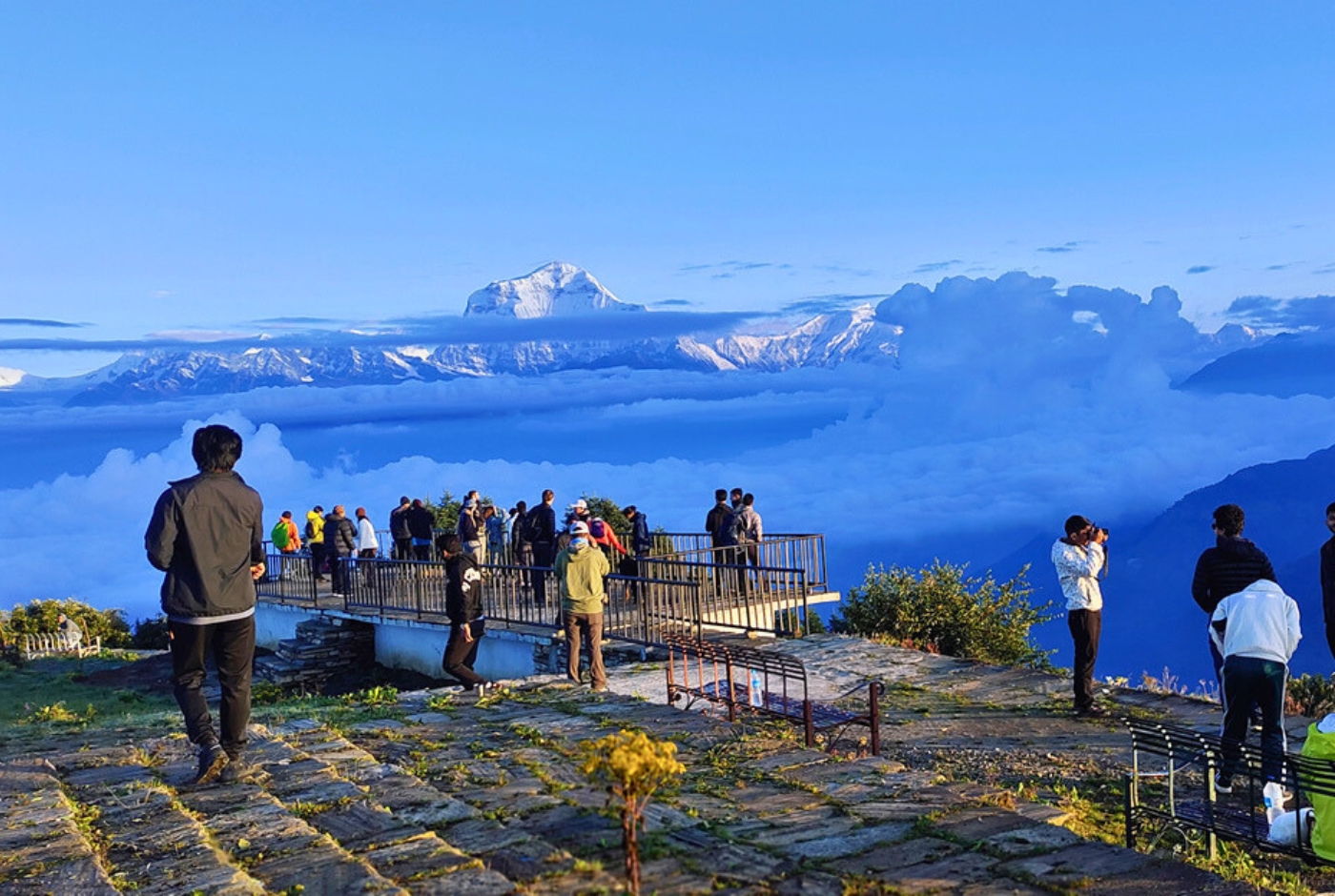
Specific Cultural Highlights
- Ghandruk: A major cultural stop, known for its strong Gurung identity. Visit the Gurung Museum, watch traditional dances, and explore homes built in classic style.
- Chhomrong: A Gurung village where trekkers often stay overnight, offering a relaxed chance to connect with locals and enjoy home-cooked meals.
- Jhinu Danda: Beyond its rejuvenating hot springs, Jhinu offers quiet village life and a friendly atmosphere ideal for cultural exchange.
- Poon Hill (optional route): While best known for its sunrise views, this stop also allows time in Ghorepani, a Magar village with cultural depth and hospitality.
- Annapurna Conservation Area Project (ACAP) Office: If passing through Ghandruk or other checkpoints, the ACAP office provides insight into local conservation efforts and community-based tourism initiatives.
Electricity on Annapurna Base Camp Trek
Electricity on the Annapurna Base Camp trek is there, but it’s hit or miss, especially the higher you go. Most teahouses got it, but don’t count on it being strong or steady. Down low, you’ll find places using small hydropower setups—works pretty well when the flow is strong. Higher up, they switch to solar. If the sky’s clear, you’re good. If it’s cloudy, forget it. No sun, no charge.
You can charge your stuff in the teahouses, yeah, but it costs—usually a couple bucks per device. Depends on the place. Some have better setups, some barely keep the lights on. Always ask when you get there. Some charge inside your room, some only in the dining hall. Don’t expect it to be free.
It’s smart to carry a power bank. That’ll save you when there’s no charge to be found. If you’ve got a camera or extra gear, bring extra batteries too. You don’t want to be halfway up the trail with a dead phone or camera.
The weather really plays a part. Sun’s out, you’ll be okay. But cloudy days? Charging slows down big time. And don’t be surprised if you have to wait your turn—everyone’s trying to charge at once. Be patient, plan ahead, and don’t rely on every stop having power.
Bottom line—power’s there, but it’s shaky. Come ready with backups, ask around, and keep your gear topped up when you can.
Is there Electricity in Annapurna Base Camp teahouses? Can I charge my device?
The predominant means of electricity generation at Annapurna Base Camp is solar power. Lodges utilize photovoltaic panels to harness solar energy, which is then stored in batteries to supply power. While micro-hydroelectric projects may be present in villages at lower elevations along the Annapurna Sanctuary trek, solar energy is the practical and prevalent solution at the Base Camp itself due to its remote location and environmental conditions.
Facilities for charging electronic devices are available at the lodges in Annapurna Base Camp. However, it is essential for visitors to understand that this service typically incurs a fee (NRS 200-1000) per device and applies to all visitors, including Nepalese ones. The cost for charging can vary from one lodge to another and is generally higher than at lower altitudes, reflecting the expense and difficulty of generating and maintaining power in such a remote environment.
The availability and reliability of power for charging can be influenced by weather conditions, particularly the amount of sunshine received by the solar panels. During periods of overcast weather or high demand, the power supply might be limited, or lodges may restrict charging to specific hours. Therefore, while charging is possible, continuous, uninterrupted access cannot always be guaranteed. It is also advisable to carry a universal travel adapter, as plug socket types can differ. Switch off your device while you are in Annapurna Base Camp, if you are not using it, because due to the cold temperature, your gadget's power may automatically get low, especially during the night.
Wi-Fi and Internet
Wi-Fi on the Annapurna Base Camp trek? It’s around, but don’t expect much. Some teahouses say they’ve got it, and technically they do—but it’s slow, patchy, and tends to drop out when you need it most. Usually, it’s only available in the dining hall, and if there’s a crowd trying to use it, good luck loading anything.
As for mobile signal, it's pretty hit and miss. You might get some reception in the lower villages, but once you start gaining altitude, the signal drops off fast. The mountains make it tough—no 3G, no 4G, nothing reliable once you're up high.
Some teahouses will let you use the Wi-Fi for free, but many charge a small fee—about 100 to 200 rupees a day. Even then, don’t expect smooth streaming or long video calls. It’s more like: send a quick message if it goes through, check the weather, maybe load a photo after ten tries.
People bring local SIMs or portable Wi-Fi gadgets, thinking it’ll help. Honestly? Doesn’t make much difference once you’re deeper into the trek. Best thing to do is let people know you’ll be off-grid, enjoy the trail, and forget about the internet for a bit. It’s kind of nice, actually.
Can I use Wi-Fi in Annapurna Base Camp?Wi-Fi internet access is generally available at the lodges in Annapurna Base Camp. This service is provided through satellite internet connections, as there is no terrestrial broadband infrastructure at that altitude. It is important for visitors to understand that this Wi-Fi service is not complimentary and requires an additional payment. The cost for Wi-Fi access is typically higher at ABC compared to lower elevations along the trek, reflecting the significant expense of providing satellite internet in such a remote location.
The quality and speed of the internet connection can vary. It is usually suitable for basic communication such as sending emails, using messaging apps (like WhatsApp or Messenger), and light web browsing. However, it is generally not designed for high-bandwidth activities such as video calls, streaming media, or downloading large files. The connection speed can also be affected by the number of users sharing the network, weather conditions impacting the satellite signal, and the specific satellite plan subscribed to by the lodge.
It's plausible that WorldLink Communications has extended its internet services to Annapurna Base Camp (ABC), as evidenced by signage at the entry point. In 2019, WorldLink announced plans to provide internet connectivity at ABC as part of its initiative to expand free Wi-Fi hotspots across Nepal, including remote areas like the Annapurna region. However, as of now, there is no official confirmation or detailed information available regarding the operational status, coverage quality, or user experiences of WorldLink's services specifically at ABC. Most lodges along the Annapurna Base Camp trek route continue to rely on satellite-based internet services.
Network Coverage
If you’re heading out on the Annapurna Base Camp trek and want a SIM that’ll actually work when you need it most, go with NTC—Nepal Telecom. Between NTC and Ncell, both are used in Nepal, but up in the mountains, NTC handles the tough terrain a lot better. You’ll get a stronger signal in the remote spots, especially as you gain altitude. Ncell might do alright in towns or lower down, but once you’re deeper into the trail, its signal starts to vanish.
NTC gives you decent 3G in most areas along the route. 4G is more hit or miss, but you’ll be able to check messages or the weather without too much fuss. Plus, their data packages are solid—day packs, full data bundles, even unlimited options if you really need to stay connected. You can grab a prepaid NTC SIM easily in Kathmandu, Pokhara, or even right at the airport. Super convenient.
Now, if you're just planning to stay around towns or popular lower trails, Ncell might give you faster speeds when it works. They even offer a “Visit Nepal SIM” for tourists. But the problem is, it doesn’t reach far. Once you're high up or off the beaten path, Ncell starts fading fast. Weather and altitude mess with the signal a lot more than with NTC.
So yeah—if you want your phone to stay alive network-wise once you’re in the real mountain stuff, NTC is the way to go. You’ll still hit dead zones here and there, but it’s way more reliable than the other option.
Mobile network connectivity at Annapurna Base Camp
Mobile network connectivity at Annapurna Base Camp (ABC) is possible, though it can be inconsistent and should not be relied upon for continuous, high-speed access. Among the major Nepali telecommunication providers, NTC (Nepal Telecom) generally offers better coverage in remote and high-altitude regions like the Annapurna Sanctuary, including ABC. While Ncell has been expanding its network, NTC often has a more established presence in these areas.
If a signal is available, it is frequently limited to 2G or very basic 3G services. This would be sufficient for voice calls and sending/receiving SMS text messages. Data services, if accessible at all through the mobile network, will typically be very slow and unreliable, suitable perhaps for sending a simple text-based email or a WhatsApp message without media.
Drinking Water
Ensuring safe drinking water on the Annapurna Base Camp trek in 2025 remains a top priority. While water sources are abundant along the trail, they often require purification to be safe for consumption. Trekkers have several options to secure potable water:
Boiled Water: Teahouses along the route typically offer boiled water for a small fee, usually between NPR 100 to NPR 200 per litre. This method is reliable, as boiling effectively kills harmful microorganisms. It's advisable to carry a reusable water bottle to minimize plastic waste and refill with boiled water at these establishments .
Water Purification Tablets and Filters: Carrying water purification tablets or portable filters allows trekkers to treat water from natural sources like streams and taps. Chlorine or iodine-based tablets are commonly used; they are lightweight and cost-effective. After treating the water, it's recommended to wait at least 30 minutes before consumption to ensure effectiveness. Portable filters, such as straw filters, can also be effective, especially when combined with purification tablets for added safety.
Bottled Water: While bottled water is available at lower elevations, it's discouraged due to environmental concerns related to plastic waste. Moreover, as altitude increases, the availability of bottled water decreases, and prices rise. Therefore, relying on boiled water or purification methods is both eco-friendly and practical .
Insulated Water Bottles: At higher altitudes, temperatures can drop significantly, leading to the risk of water freezing. Using insulated water bottles helps keep water from freezing and maintains a drinkable temperature throughout the trek.
Hydration and Altitude Considerations: Staying hydrated is crucial for acclimatization and preventing altitude sickness. Trekkers should aim to drink at least 3 to 4 liters of water daily. Starting the day with a warm beverage and sipping water regularly can help maintain hydration levels.
Environmental Responsibility: The Annapurna region is a protected area, and minimizing plastic waste is essential. Trekkers are encouraged to use reusable bottles and purification methods instead of relying on single-use plastic bottles.
Safety Precautions: It's important never to drink directly from natural water sources without proper purification, as they may contain harmful microorganisms. Always treat or boil water before consumption to ensure safety.
Drinking water at Annapurna Base Camp
The most common and reliable method offered by lodges at Annapurna Base Camp is providing boiled water. Lodge staff will boil local spring or glacial meltwater, making it safe for consumption. This water is typically sold per liter or per thermos/flask refill. While effective, it incurs a cost that increases with altitude. Many trekkers prefer this, especially in cold weather, as it can be used for drinking and for filling hot water bottles.
Some lodges, particularly those adhering to sustainable tourism practices encouraged by organizations like the Annapurna Conservation Area Project (ACAP) and the Trekking Agencies' Association of Nepal (TAAN), may offer filtered or UV-treated water. These "Safe Drinking Water Stations" aim to reduce plastic bottle waste. The water is typically sourced locally and then passed through a robust filtration system or treated with UV light. This option is usually cheaper than bottled water and more environmentally friendly. The availability of such stations directly at ABC can vary, but they are becoming more common along the entire trekking route.
Commercially bottled mineral water is not available for purchase at the lodges in Annapurna Base Camp. It is strongly discouraged due to the significant environmental problem of plastic waste in the mountains. The Annapurna Conservation Area Project actively campaigns against the use of plastic bottles.
Toilet Facilities
Right, let’s talk toilets on the Annapurna Base Camp trek. It’s not exactly five-star luxury, but it’s all part of the adventure.
Toilets on the Trail: Down in the lower villages, you might find Western-style loos—though sometimes they’re missing a seat or the flush is a bit dodgy. As you climb higher, squat toilets become the norm: just a hole in the ground with footrests. They’re basic but get the job done. Don’t expect toilet paper to be provided, so bring your own stash. Hand sanitiser and wet wipes are also essential, as soap and running water can be scarce.
Toilets at ABC
Squat Toilets (Asian Style): These are the most common type of toilet you will encounter in the lodges at Annapurna Base Camp. They consist of a ceramic pan or a designated hole in the floor over which one squats. Western-Style Toilets (Sit-Down): Some lodges, particularly newer ones or those aiming for a slightly higher standard, might offer a limited number of Western-style sit-down toilets. However, these are less prevalent than squat toilets. Do not assume every lodge will have one.
Toilets are generally located in a separate block or area outside the main dining and sleeping quarters of the lodge. They are almost always shared facilities for all guests staying at the lodge. Private en-suite toilets are exceptionally rare, if available at all, at this altitude and in this type of accommodation.
Flushing is typically manual. This usually involves using a bucket of water (provided in or near the toilet cubicle) and a smaller scoop or jug to pour water into the toilet pan to clear waste. Automated flush systems are uncommon. The water for flushing is often very cold, and in freezing temperatures, water sources can sometimes freeze overnight, leading to temporary issues until it thaws. Waste from these toilets is typically directed into septic tanks or, in more basic setups, pit latrines. Efforts are made to manage waste, but the high-altitude environment presents challenges.
Showers and Hygiene:
f you're trekking to Annapurna Base Camp in 2025, hot showers are still available—but don't expect spa-level luxury. Most teahouses offer hot showers, usually for a fee. Prices can range from NPR 300 to NPR 700, depending on altitude and availability. At lower elevations, you might find proper showers, but higher up, it's often a bucket of hot water.
A standout spot to unwind is Jhinu Danda, a village at 1,760 meters known for its natural hot springs. After days on the trail, soaking in these warm waters by the Modi Khola River is a treat. It's about a 20-minute walk from the village, and the springs are closed during the monsoon season (June–July).
So, while hot showers are available, they're basic and come at a cost. But after a long day's trek, even a simple warm rinse can feel like a luxury.
Shared Facilities: Most teahouses offer shared bathroom facilities. At lower elevations, you might get a private bathroom, but higher up, it’s communal all the way. It’s a good idea to carry a head torch for nighttime visits.
- Always carry your own toilet paper and hand sanitiser.
- Be prepared for basic facilities, especially at higher altitudes.
- Embrace the experience—it’s all part of the trekking adventure!
Final Note
Annapurna Base Camp is the best trekking destination if you want to walk close to an 8000m mountain within a short duration. The trek introduces you to a typical Nepalese landscape – terraced fields, traditional villages, and forested hills. Children as young as eight years old and adults as old as seventy have been able to trek to ABC. The only criteria to complete this amazing trek is to have a fit body and strong determination.



